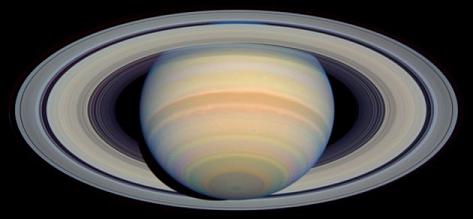On New Year's Eve, Lord of the Rings - the planet Saturn will be at a brighter point than at any time in the last thirty years. Throughout the coming month, sky watchers will be able to enjoy Saturn at its best. Such an opportunity would not be repeated for the next thirty years
Avi Blizovsky

Saturn in visible light, as imaged by the Hubble Space Telescope
Direct link to this page: https://www.hayadan.org.il/saturn091203.html
If Mars, whose closest approach in 60 thousand years was the hit of the summer, on December 31st Saturn will be in exact opposition to the Sun in relation to the Earth. This means that from our direction, Saturn will rise at solstice and reach its maximum height in the southern sky (in the winter the sun is on the southern side of the equator and therefore also Saturn opposite it) and will set when the sun rises. Astronomers call this "contrast".
Saturn takes 29.42 years to orbit the sun. Its orbit is not an exact circle, and on July 26 of this year it was at the closest point to the sun in its orbit - the perihelion. A fortuitous proximity between the perihelion phase and opposition necessitates the fact that on New Year's Eve, Saturn will be closest to the Sun than it has been at any point since December 1973.
The Lord of the Rings will then be 1.2 billion kilometers from Earth. It will not approach again until January 2034. This year's opposition will be closer to the Sun than the opposition expected in June 2018 when the planet will be 1.35 billion kilometers from Earth.
And there is also a bonus: Saturn's rings are not always facing us in a way that is convenient for viewing. Sometimes we only see their ends from the angle at which they are directed towards us and then the appearance is not particularly impressive. Currently, the rings are still at a fairly large inclination of over 25 degrees to our line of sight. This allows the rings to be seen in their full glory, and it also highlights Saturn's brightness.
By the end of December, Saturn will shine unbelievably bright, at magnitude 0.5, among the stars, only Sirius and Canopus are brighter.
Saturn is now in Gemini. Saturn will be found between the legs of the twins. Starting on Wednesday, December 10, Saturn will be very bright yellow-white below the Moon a little to the right of it and it will rise in the northeastern part of the sky.
Galileo Galilei (1564-1642) was the first to observe the rings, in 1610. Although he looked through a crude telescope this confused him, because at the angle that Saturn was then facing the Earth and considering the unpolished telescope the rings looked to him like ears protruding from the surface of the planet on each of its sides. He therefore believed that Saturn is a triangular body - two small spheres connected to one large sphere. Later, when the rings turned their thin end towards the Earth, the bumps disappeared and he evoked an old myth when he wrote: "Did Saturn swallow his children?". Galileo was pained that his mind was so weak that he could not perceive the strange phenomenon.
In fact it was not his mind or thought that was weak but his telescope. A more powerful telescope could have identified Saturn's companions as rings. This was not revealed until a young Dutch mathematician, Christian Huygens (1629-1695) used a better telescope, and on March 25, 1655, at the age of 26, he saw the rings as they really were.
In mythology, Saturn is associated with the Greek god Chronos, but is better known by the name of the Roman god of agriculture. It is commonly thought that the meaning of the Latin name Saturn comes from SATUS which means grain seeds and the verb SERERE - to scatter. But why would Saturn be associated with agriculture? Perhaps the clue can be found in the ancient Assyrians who referred to Saturn as lubadsagush, a term that can be translated as "the oldest sheep among the old sheep".
The name may have been given to it because Saturn appears to move very slowly among the stars, compared to the closer planets which move to their seasonal positions in the sky more quickly. Perhaps he also reminded the sky watchers of the slow gait of plow oxen or cows.
A closer look at Saturn will be obtained next year when the Cassini spacecraft approaches it and is expected to provide the best images and data ever collected on the sixth planet from the Sun.
Yedan Saturn
For the original news on CNN
https://www.hayadan.org.il/BuildaGate4/general2/data_card.php?Cat=~~~707089698~~~20&SiteName=hayadan
